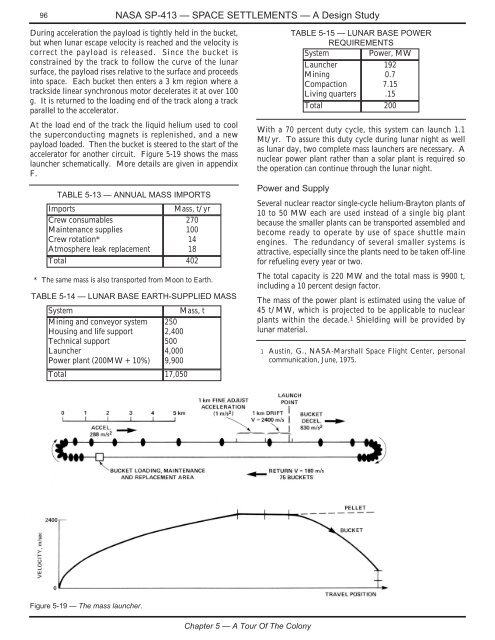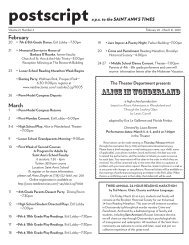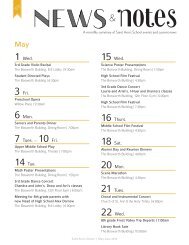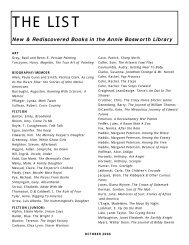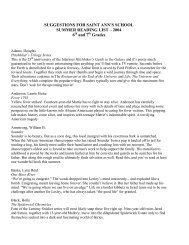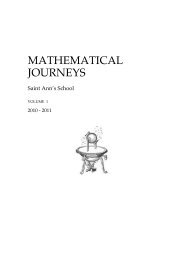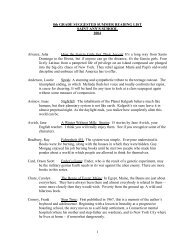NASA SP-413 Space Settlements - Saint Ann's School
NASA SP-413 Space Settlements - Saint Ann's School
NASA SP-413 Space Settlements - Saint Ann's School
Create successful ePaper yourself
Turn your PDF publications into a flip-book with our unique Google optimized e-Paper software.
96<br />
<strong>NASA</strong> <strong>SP</strong>-<strong>413</strong> — <strong>SP</strong>ACE SETTLEMENTS — A Design Study<br />
During acceleration the payload is tightly held in the bucket,<br />
but when lunar escape velocity is reached and the velocity is<br />
correct the payload is released. Since the bucket is<br />
constrained by the track to follow the curve of the lunar<br />
surface, the payload rises relative to the surface and proceeds<br />
into space. Each bucket then enters a 3 km region where a<br />
trackside linear synchronous motor decelerates it at over 100<br />
g. It is returned to the loading end of the track along a track<br />
parallel to the accelerator.<br />
At the load end of the track the liquid helium used to cool<br />
the superconducting magnets is replenished, and a new<br />
payload loaded. Then the bucket is steered to the start of the<br />
accelerator for another circuit. Figure 5-19 shows the mass<br />
launcher schematically. More details are given in appendix<br />
F.<br />
TABLE 5-13 — ANNUAL MASS IMPORTS<br />
Imports<br />
Crew consumables<br />
Maintenance supplies<br />
Crew rotation*<br />
Atmosphere leak replacement<br />
Mass, t/yr<br />
270<br />
100<br />
14<br />
18<br />
Total 402<br />
* The same mass is also transported from Moon to Earth.<br />
TABLE 5-14 — LUNAR BASE EARTH-SUPPLIED MASS<br />
System<br />
Mining and conveyor system<br />
Housing and life support<br />
Technical support<br />
Launcher<br />
Power plant (200MW + 10%)<br />
Mass, t<br />
250<br />
2,400<br />
500<br />
4,000<br />
9,900<br />
Total 17,050<br />
TABLE 5-15 — LUNAR BASE POWER<br />
REQUIREMENTS<br />
System Power, MW<br />
Launcher<br />
192<br />
Mining<br />
0.7<br />
Compaction 7.15<br />
Living quarters .15<br />
Total 200<br />
With a 70 percent duty cycle, this system can launch 1.1<br />
Mt/yr. To assure this duty cycle during lunar night as well<br />
as lunar day, two complete mass launchers are necessary. A<br />
nuclear power plant rather than a solar plant is required so<br />
the operation can continue through the lunar night.<br />
Power and Supply<br />
Several nuclear reactor single-cycle helium-Brayton plants of<br />
10 to 50 MW each are used instead of a single big plant<br />
because the smaller plants can be transported assembled and<br />
become ready to operate by use of space shuttle main<br />
engines. The redundancy of several smaller systems is<br />
attractive, especially since the plants need to be taken off-line<br />
for refueling every year or two.<br />
The total capacity is 220 MW and the total mass is 9900 t,<br />
including a 10 percent design factor.<br />
The mass of the power plant is estimated using the value of<br />
45 t/MW, which is projected to be applicable to nuclear<br />
plants within the decade. 1 Shielding will be provided by<br />
lunar material.<br />
1 Austin, G., <strong>NASA</strong>-Marshall <strong>Space</strong> Flight Center, personal<br />
communication, June, 1975.<br />
Figure 5-19 — The mass launcher.<br />
Chapter 5 — A Tour Of The Colony


